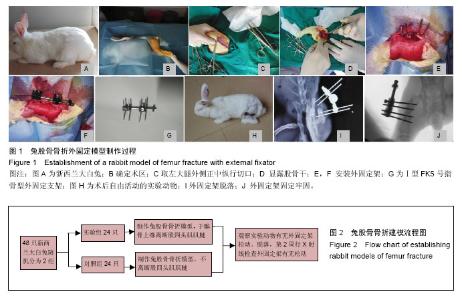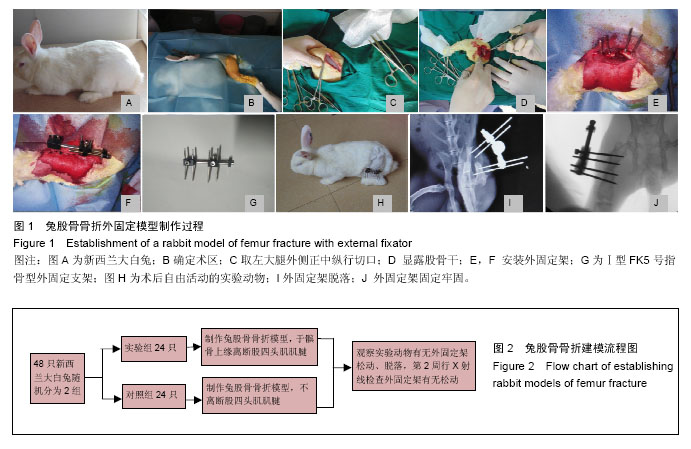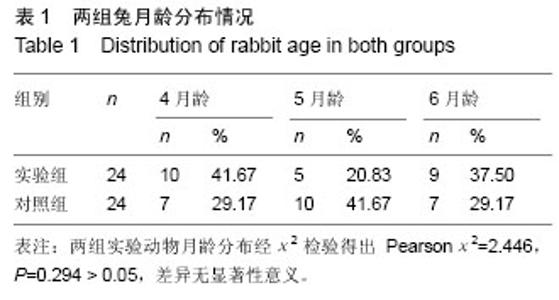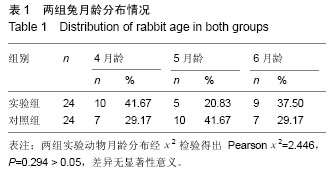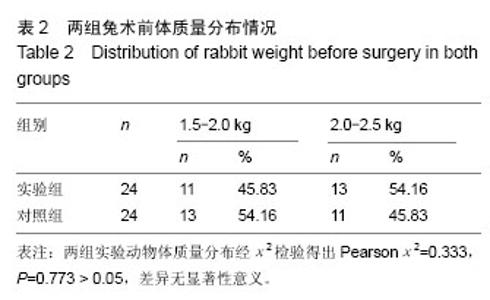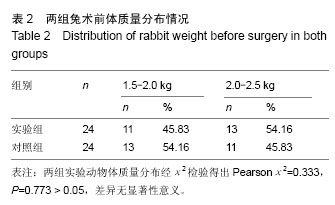Chinese Journal of Tissue Engineering Research ›› 2016, Vol. 20 ›› Issue (39): 5834-5839.doi: 10.3969/j.issn.2095-4344.2016.39.009
Previous Articles Next Articles
Relationship of quadriceps tendon and the stability of external fixator in rabbit femur fracture model
Zhang Meng, Wei Jun-qiang, Duan Jian-wei, Yan Shi
- Department of Pediatric Orthopedic Trauma, Affiliated Hospital of Chengde Medical College, Chengde 067000, Hebei Province, China
-
Revised:2016-07-02Online:2016-09-23Published:2016-09-23 -
Contact:Yan Shi, Master, Chief physician, Department of Pediatric Orthopedic Trauma, Affiliated Hospital of Chengde Medical College, Chengde 067000, Hebei Province, China -
About author:Zhang Meng, Studying for master’s degree, Department of Pediatric Orthopedic Trauma, Affiliated Hospital of Chengde Medical College, Chengde 067000, Hebei Province, China -
Supported by:the Medical Science Research Project of Hebei Province, No. ZL20140067
CLC Number:
Cite this article
Zhang Meng, Wei Jun-qiang, Duan Jian-wei, Yan Shi. Relationship of quadriceps tendon and the stability of external fixator in rabbit femur fracture model[J]. Chinese Journal of Tissue Engineering Research, 2016, 20(39): 5834-5839.
share this article
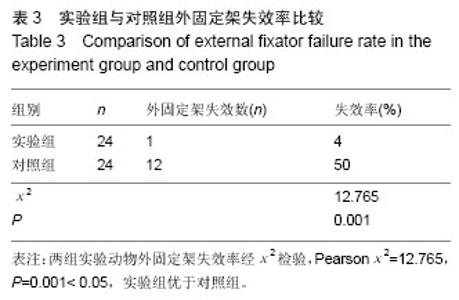
2.2 模型稳定性 制作兔股骨骨折模型是根据王永刚等[14]、郭树章等[15]、赵震宇等[16-17]和张猛等[18-19]学者的方法总结而出,比较具有代表性,其股骨骨折模型造模后稳定性根据上述学者的研究,其造模方法稳定性良好,此次实验在以上学者造模基础上增加离断股四头肌肌腱一步骤,基本不影响以上学者证明的造模的稳定性。 2.3 大体观察 实验动物于相同的清洁级环境中饲养,大白兔术前及术后可自由活动。2组实验动物术后当天切口均可见少量血性液体渗出,切口经过换药3 d后渗出逐渐减少至干燥结痂,八九天切口基本愈合。最初3 d实验动物均出现不同程度萎靡,患肢跛行,进食减退,只饮少量水,1周后大部分兔食量正常。2周内实验组1只兔外固定架螺钉松动脱落,对照组5只实验兔仅外固定架螺母松动掉落,5只实验兔仅外固定架螺钉松动脱落,2只实验兔螺母及螺钉均松动脱落。全部实验动物术后可自由活动,3 d后恢复术前状态,步态无异常。实验期间,全部实验动物均正常健康生长。 2.4 X射线检查 术后2周给予所有动物行X射线检查,实验组1只兔外固定架螺钉游离于股骨外,对照组7只实验兔外固定架螺钉游离于股骨外,其中1只螺钉折断,螺纹部分留置于股骨内。 2.5 实验组与对照组外固定架失效率比较 见表3。"
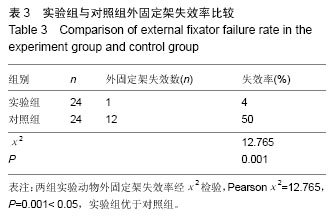
| [1] Nehrbass D,Arens D,Zeiter S.Spontaneous bilateral avulsion fracture of the tuberositas tibiae in a New Zealand White rabbit-A counterpart to Osgood-Schlatter disease in humans?. Exp Toxicol Pathol. 2015;67(2):223-227.
[2] Cao Z,Jiang D, Yan L,et al.In vitro and in vivo osteogenic activity of the novel vancomycin-loaded bone-like hydroxyapatite/poly (amino acid) scaffold.J Biomater Appl.2016;30(10):1566-1577.
[3] Halanski MA, Yildirim T, Chaudhary R, et al.Periosteal Fiber Transection During Periosteal Procedures Is Crucial to Accelerate Growth in the Rabbit Model. ClinOrthopRelat Res.2016;474(4):1028-1037.
[4] Friel NA, McNickle AG, DeFranco MJ, et al. Effect of highly purified capsaicin on articular cartilage and rotator cuff tendon healing: An in vivo rabbit study. J Orthop Res. 2015;33(12):1854-1860.
[5] Takahashi M, Noda M, Saegusa Y.A new treatment for avulsion fracture of the calcaneus using an Ilizarov external fixator. Injury.2013;44(11): 1640-1643.
[6] Bumbasirevic M, Atkinson HD, LesicA.Ilizarov treatment of scaphoid nonunion. Injury.2013;44(3): 346-350.
[7] Popkov A, Aranovich A, Popkov D.Prevention of recurrence of tibia and ankle deformities after bone lengthening in children with type II fibular hemimelia. Int Orthop. 2015;39(7):1365-1370.
[8] Elmadag M, Uzer G, Yildiz F, et al.Comparison of four different techniques for performing an osteotomy a biomechanical, radiological and histological study on rabbits tibias.Bone Joint J.2015;97-B(12):1628-1633.
[9] Qu H,Knabe C,Radin S, et al.Percutaneous External Fixator Pins with Bactericidal Micron-Thin Sol-Gel Films for the Prevention of Pin Tract Infection. Biomaterials. 2015;62:95-105.
[10] Ostrum RF, Litsky AS, Anson LW. Limited internal fixation of the tibia with external fixation: an in vivo canine study. J Orthop Trauma. 1994; 8(1): 50-53.
[11] Schumacher M,NeumannS.Clinical use of the U-shaped external fixator with enhanced threadplate (UFEG®).Tierarztl Prax Ausg K Kleintiere Heimtiere. 2014;42(1):5-12..
[12] 谢伟.人造血管在兔腓肠肌腱损伤修复术后套接预防粘连的作用[J]. 青海医学院学报, 2012, 33(4): 278-280.
[13] Higano M, Tachibana Y, Sakaguchi K, et al. Effects of tunnel dilation and interference screw position on the biomechanical properties of tendon graft fixation for anterior cruciate ligament reconstruction. Arthroscopy. 2013;29(11):1804-1810.
[14] 王永刚,裴国献,张洪涛,等.兔股骨干缺损模型的制备及在组织工程骨实验中的应用[J].中华创伤骨科杂志, 2005, 7(10):971-974.
[15] 郭树章,季明华,许刚,等.兔骨折延迟愈合动物模型的建立[J].实用骨科杂志,2012,18(3):230-232.
[16] 赵震宇,邵林,刘建宇,等.微型外固定器制作大鼠股骨萎缩型骨不连模型的实验研究[J].中华创伤骨科杂志, 2011, 13(3):261-264.
[17] 赵震宇,邵林,刘建宇,等.外固定方法制作的大鼠股骨骨折模型[J]. 中国组织工程研究与临床康复, 2011, 15(24): 4387-4390.
[18] 张猛,魏俊强,段建伟,等. 外固定架制作兔股骨骨折模型[J].中国临床研究,2016,29(5): 685-686.
[19] 张猛,魏俊强,段建伟,等.采用单边可调节外固定架制作兔股骨非感染性骨折不愈合模型[J].新医学,2016,47(7): 437-441.
[20] Melvin AJ, Litsky AS, Mayerson JL, et al. Extended healing validation of an artificial tendon to connect the quadriceps muscle to the Tibia: 180‐day study. J Orthop Res. 2012;30(7):1112-1117.
[21] Franchi M, Quaranta M, Macciocca M, et al. Structure relates to elastic recoil and functional role in quadriceps tendon and patellar ligament. Micron.2009, 40(3): 370-377.
[22] 邢丹,马信龙,马剑雄,等.大鼠股骨干开放骨折愈合模型的建立及生物力学性能评价[J].中国骨伤, 2013, 21(8): 676-680.
[23] 邢丹,马信龙,陈阳,等.大鼠股骨干开放骨折愈合模型的建立及生物力学性能评价[C]//第二十届全国中西医结合骨伤科学术研讨会、第二届中国医师协会中西医结合医师分会骨伤科学术年会、第十九届浙江省中西医结合骨伤科专业委员会学术年会论文. 2013.
[24] 费志强,熊建义,刘志勇,等.大鼠股骨缺损模型中BBP增强BMP-2的骨诱导作用[J].生物骨科材料与临床研究, 2013, 10(4):1-7.
[25] 卢旻鹏,王群波,董靖,等.纳米羟基磷灰石/聚酰胺66/富血小板血浆复合物修复兔股骨中段骨缺损的实验研究[J]. 重庆医学, 2015, 44(7):885-887.
[26] 韩大为,李良华,王清玉,等. Ilizarov牵张技术对挛缩跟腱组织学改变的实验研究[J].中华骨科杂志, 2011, 31(12): 1362-1367.
[27] Cole G, Weigel J, Headrick A, et al. Multiple pathological fractures and delayed union associated with lead exposure in a German Shepherd Dog. Aust Vet J. 2015;93(10):373-376.
[28] 孙希诰.用放射免疫分析法对正常小鼠,大鼠,豚鼠,家兔和狗血浆皮质酮和皮质醇的研究 (摘要)[J]. 第一军医大学学报,1986, 4: 8.
[29] 巩望松.用放射性微球测量狗,家兔,鼠全身骨骼上的血流分布[J]. 国外医学:生物医学工程分册,1987, 1: 34.
[30] 陈小蒙,叶华.家兔活体解剖在《解剖学》实验教学中的运用探讨[J].临床和实验医学杂志, 2007,6(6):186-186.
[31] 薛帮群,邓雯,陈菊娥,等.青年肉兔的解剖学研究(一)[J]. 河南科技大学学报:农学版, 1990, 4:7-11.
[32] 韩大为,李良华,王清玉,等.Ilizarov 技术对关节软骨病理改变的实验观察[J].中国骨伤,2009,22 (12): 923-926.
[33] 殷力,李弘帅,韩奇财,等.阿仑膦酸钠/磷酸钙骨水泥和同种异体骨修复兔股骨骨缺损的比较[J].中华实验外科杂志,2014,31(2): 372-374.
[34] 石义刚,王立春,陶六遵.壮骨片治疗股骨头缺血性坏死的实验研究[J]. 哈尔滨商业大学学报:自然科学版, 2002, 1:69-72.
[35] Felfel RM, Ahmed I, Parsons AJ, et al. Investigation of crystallinity, molecular weight change, and mechanical properties of PLA/PBG bioresorbable composites as bone fracture fixation plates. J Biomater Appl. 2012; 26(7):765-789.
[36] 肖湘,张铁良.股骨转子下骨折内固定失败原因分析[J]. 中华骨科杂志, 2006, 26(3): 187-190.
[37] 廖浩,方煌,陈安民. 60 例四肢长管骨骨不连的原因分析 [J]. 中国矫形外科杂志, 2005, 13(16): 1207-1209.
[38] 林国兵李平生.超关节外固定器治疗胫腓骨下段开放粉碎性骨折[J].中华骨科杂志,1997,17(9): 580-581.
[39] Schreiber VM, Tarkin IS, Hildebrand F, et al. The timing of definitive fixation for major fractures in polytrauma—A matched-pair comparison between a US and European level I centres: Analysis of current fracture management practice in polytrauma. Injury. 2011; 42(7): 650-654.
[40] Cheng W, Li Y, Manyi W. Comparison study of two surgical options for distal tibia fracture-minimally invasive plate osteosynthesis vs. open reduction and internal fixation. International orthopaedics.2011;35(5): 737-742.
[41] Molony DC, Kennedy J, Gheiti A, et al. Free-hand versus novel specialised jig guidance for the passing of intramedullary wires in olecranon fracture fixation: A comparative study. Injury.2011;42(4): 343-346.
[42] 刘爱国,谷文光,邓亮,等.不同手术方法治疗老年股骨转子间骨折疗效分析[J].中国矫形外科杂志,2012,20(12): 1072-1075. |
| [1] | Shi Bin, An Jing, Chen Long-gang, Zhang Nan, Tian Ye . Influencing factors for pain after total knee arthroplasty [J]. Chinese Journal of Tissue Engineering Research, 2017, 21(7): 993-997. |
| [2] | Wang Xian-xun. Impact of local compression cryotherapy combined with continuous passive motion on the early functional recovery after total knee arthroplasty [J]. Chinese Journal of Tissue Engineering Research, 2017, 21(7): 998-1003. |
| [3] | Yuan Wei, Zhao Hui, Ding Zhe-ru, Wu Yu-li, Wu Hai-shan, Qian Qi-rong. Association between psychological resilience and acute mental disorders after total knee arthroplasty [J]. Chinese Journal of Tissue Engineering Research, 2017, 21(7): 1015-1019. |
| [4] | Chen Qun-qun, Qiao Rong-qin, Duan Rui-qi, Hu Nian-hong, Li Zhao, Shao Min. Acu-Loc®2 volar distal radius bone plate system for repairing type C fracture of distal radius [J]. Chinese Journal of Tissue Engineering Research, 2017, 21(7): 1025-1030. |
| [5] | Huang Xiang-wang, Liu Hong-zhe. A new low elastic modulus of beta titanium alloy Ti2448 spinal pedicle screw fixation affects thoracic stability: biomechanical analysis [J]. Chinese Journal of Tissue Engineering Research, 2017, 21(7): 1031-1035. |
| [6] | Xie Qiang. Three-dimensional finite element model for biomechanical analysis of stress in knee inversion and external rotation after posterior cruciate ligament rupture [J]. Chinese Journal of Tissue Engineering Research, 2017, 21(7): 1036-1040. |
| [7] | He Ze-dong, Zhao Jing, Chen Liang-yu, Li Ke, Weng Jie. Multilevel finite element analysis on the biological tribology damage of water on bone tissue [J]. Chinese Journal of Tissue Engineering Research, 2017, 21(7): 1041-1045. |
| [8] | Jiang Zi-wei, Huang Feng, Cheng Si-yuan, Zheng Xiao-hui, Sun Shi-dong, Zhao Jing-tao, Cong Hai-chen,Sun Han-qiao, Dong Hang. Design and finite element analysis of digital splint [J]. Chinese Journal of Tissue Engineering Research, 2017, 21(7): 1052-1056. |
| [9] | Wang Fei, Liu Zhi-bin, Tao Hui-ren, Zhang Jian-hua, Li Chang-hong, Cao Qiang, Zheng Jun, Liu Yan-xiong, Qu Xiao-peng. Clinical efficacy of preoperative osteotomy designs using paper-cut technology versus photoshop software for ankylosing spondylitis with kyphosis [J]. Chinese Journal of Tissue Engineering Research, 2017, 21(7): 1057-1063. |
| [10] | Li Hui, Ma Jun-yi, Ma Yuan, Zhu Xu . Establishment of a three-dimensional finite element model of ankylosing spondylitis kyphosis [J]. Chinese Journal of Tissue Engineering Research, 2017, 21(7): 1069-1073. |
| [11] | Ling Guan-han, Ou Zhi-xue, Yao Lan, Wen Li-chun, Wang Guo-xiang, Lin Heng-feng. Establishment of simulating three-dimensional model of China-Japan Friendship Hospital Classification for L type osteonecrosis of the femoral head [J]. Chinese Journal of Tissue Engineering Research, 2017, 21(7): 1074-1079. |
| [12] | Fu Wei-min, Wang Ben-jie. Assessing the degree of necrotic femoral head, and association of blood supply with pathlogical changes: study protocol for a diagnostic animal trial [J]. Chinese Journal of Tissue Engineering Research, 2017, 21(7): 1086-1091. |
| [13] | Zhang Wen-qiang, Ding Qian, Zhang Na. Associations between alpha angle and herniation pit on oblique axial magnetic resonance imaging in asymptomatic hip joints of adults [J]. Chinese Journal of Tissue Engineering Research, 2017, 21(7): 1098-1103. |
| [14] | Sun Xiao-xin1, Zhou Wei2, Zuo Shu-ping3, Liu Hao1, Song Jing-feng1, Liang Chun-yu1. Morphological characteristics for the magnetic resonance imaging assessment of discoid lateral meniscal tears in children [J]. Chinese Journal of Tissue Engineering Research, 2017, 21(7): 1104-1109. |
| [15] | Lin Han-wen, Wen Jun-mao, Huang Chao-yuan, Zhou Chi, Tang Hong-yu. Correlation between the changes in lower limb power line and pain area in the knee osteoarthritis patients: imaging evaluation [J]. Chinese Journal of Tissue Engineering Research, 2017, 21(7): 1110-1114. |
| Viewed | ||||||
|
Full text |
|
|||||
|
Abstract |
|
|||||
